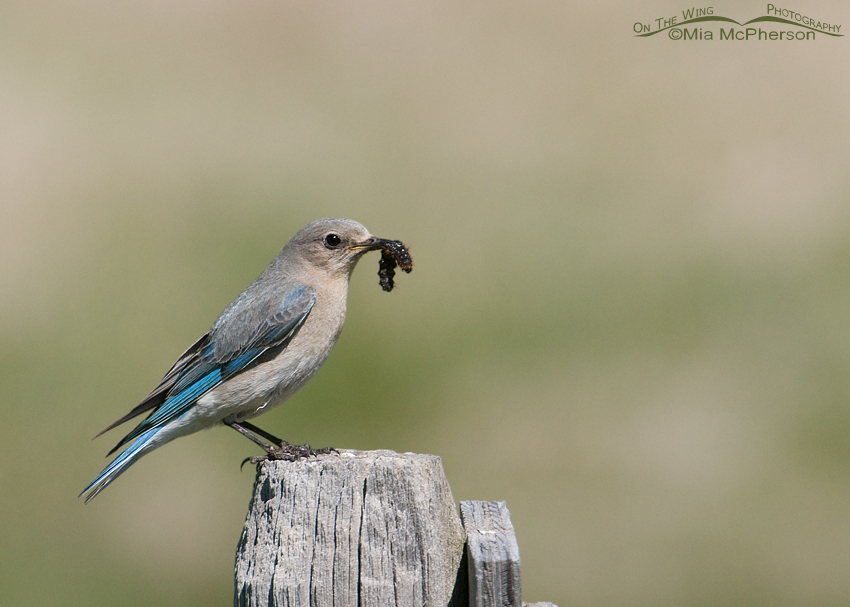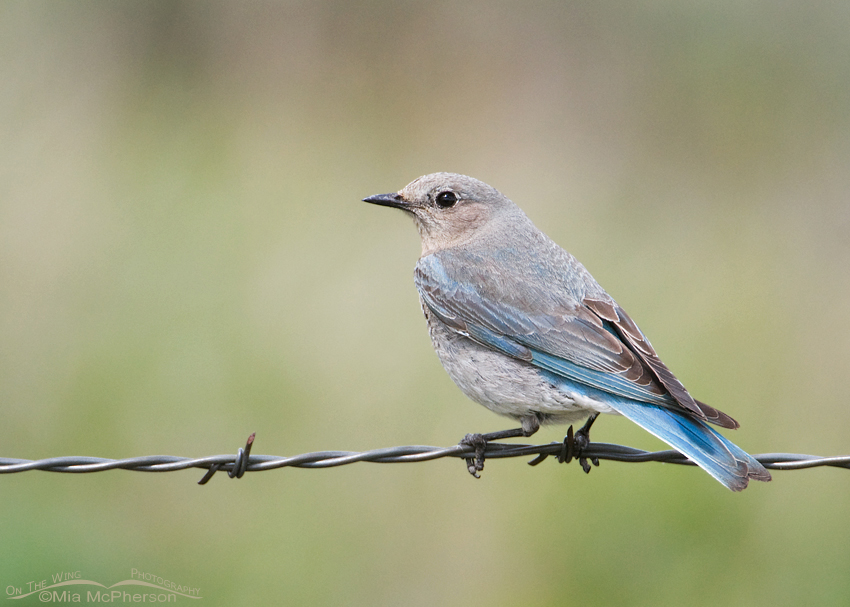 Mountain Bluebird female with prey for her young – Nikon D300, f7.1, 1/1600, ISO 640, Nikkor 200-400mm VR with 1.4x TC at 400mm, natural light, not baited
Mountain Bluebird female with prey for her young – Nikon D300, f7.1, 1/1600, ISO 640, Nikkor 200-400mm VR with 1.4x TC at 400mm, natural light, not baited
There were Mountain Bluebirds everywhere I looked on my recent trip to Montana where flashes of their brilliant blue plumage were a delight to my eyes. Mountain Blue birds are secondary cavity nesters which means they don’t create their own cavities but do use the cavities that other birds create, for instance Woodpeckers create their own cavities and bluebirds can use them later. Mountain Bluebirds have made a comeback since people started placing nest boxes in areas where they breed.
 Female Mountain Bluebird on barbed wire – Nikon D300, f6.3, 1/640, ISO 640, Nikkor 200-400mm VR with 1.4x TC at 400mm, natural light, not baited
Female Mountain Bluebird on barbed wire – Nikon D300, f6.3, 1/640, ISO 640, Nikkor 200-400mm VR with 1.4x TC at 400mm, natural light, not baited
Mountain Bluebirds inhabit grasslands, open canyons, and alpine meadows in western North America. These female Mountain Bluebirds are more subtly colored than their male counterparts but I find that subtlety very appealing.
Both sexes were very busy bringing insects to their young in the nest boxes on my recent trip north, by now perhaps some of the chicks will have already fledged. Last year there was a late snow in the Centennial that caused mortality for the chicks of the earlier nesters, hopefully this year there will be far more flashes of blue in the Big Sky of western Montana!
Life is good.
Mia
Click here to see more of my Mountain Bluebird photos plus facts and information about this species.


Gorgeous girls Mia. You know I love Bluebirds of any subspecies but Mountain Bluebirds are one of my faves. I consider myself lucky if I get to see them during the year, usually at a yearly Audubon campout at Lassen Volcanic National Park which is coming up next month! It looks like they must be feeding chicks just like my Western Bluebirds are
Larry, the chicks of these birds are about to or have fledged and some of the later nesters are starting to breed now too. This year looks like it will have a bounty of Mountain Bluebird fledglings in these locations. Last year quite a few were lost to some late snows and harshly cold weather. I’m looking forward to the bluebird images you take at Lassen Volcanic National park this year!
Thanks for commenting.
Wow Mia! I’ve just been catching up with marmots, Lark Sparrows and Mountains Bluebirds and every post is awesome. What a wonderful trip, thank you so much for sharing your beautiful images.
Thank you Kim, Montana offers up a cornucopia of delights to photograph!
Beautiful and with food in its mouth!
Thanks Bob, prey in the bill is always wonderful to photograph!
I have never seen a Mountain Bluebird before so it is especially nice for me to view your wonderful photographs. The females really are stunning birds! As always, your photographs are exquisite!
Thank Julie, I hope you get to see & photograph Mountain Bluebirds soon.
Excellent Colors ( and colours it amazes me how you get such pristine settings.. ie not just the bird but the perfect backdrop.. and presumably these birds don’t wait around for you ;).. Anyway, excellent photos.
it amazes me how you get such pristine settings.. ie not just the bird but the perfect backdrop.. and presumably these birds don’t wait around for you ;).. Anyway, excellent photos.
Stu, you are right, these birds don’t wait around for me, you should see how many I dump because they have flown off and all I have in the image is a portion of the bird’s tail! The background is usually quite a bit distant from the bird and that along with the bokeh of my lens creates those lusciously smooth backgrounds.
Very nice the subtlety of its colour!
Thanks Maria!
In Loveland, CO, in late April, we had two snow storms that killed a lot of Mt. blue birds. I found two in my yard, very sad.
Beautiful birds, beautiful photos!
I’m sorry to hear about the bluebirds dying in Loveland Sheila, it must have been heart wrenching to find the two in your yard.
Thank you for commenting on these photos.
Gorgeous photos. I love Mountain Bluebirds, and I have a real weakness for photos of birds on a barbed wire fence. Lovely!
Linda, I love to photograph birds on rusty old barbed wire (new shiny barbed wire not so much) and bluebirds seem to perch on barbed wire often! Thanks for commenting.
My heart goes out to you over the loss of your dog, it is a pain that is difficult to bear as I know from experience.
How beautiful is that!
The only time we saw them is when we go to southern Utah.
Judy, they do migrate through Antelope Island in spring & fall, I have seen them most often at the Bridger Bay campground. But you can head to higher country and see them closer than southern Utah too.
Fantastic shots of the female Mia! I agree that while the males often dominate our visual senses with their sky-blue plumage, the females are equally beautiful in their own right.
I agree Neil! Females are equally as beautiful in their own right. Thanks for commenting.